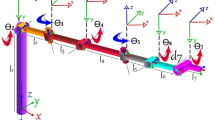Abstract
In order to overcome the complexity in solving the inverse kinematics calculation of 7-DOF serial manipulator, a new approach CPABC based on artificial bee colony (ABC) algorithm is proposed. CPABC uses the chaotic mapping to optimize the population distribution of the initial food sources to get rid of the local optimization. The whole group of food sources in CPABC is divided into several subgroups which evolve independently and communicate with each other at a certain frequency to improve the convergence rate. To balance the global and local exploitation, two control parameters are introduced to adjust the search step and the change frequency of the optimization parameter when searching the new food source. CPABC is applied to the inverse kinematics calculation of 7-DOF serial manipulator. the simulation results show that CPABC has stronger global searching ability and more fast convergence rate than that of other ABC algorithms.







Similar content being viewed by others
References
Akay B, Karaboga D (2012) A modified artificial bee colony algorithm for real-parameter optimization. Inf Sci 192:120–142
Al-Mashhadany YI (2010) Inverse kinematics problem (ikp) of 6-dof manipulator by locally recurrent neural networks (lrnns). In: 2010 International conference on management and service science (MASS), IEEE, pp 1–5
Alatas B (2010) Chaotic bee colony algorithms for global numerical optimization. Expert Syst Appl 37(8):5682–5687
Back T (1996) Evolutionary algorithms in theory and practice: evolution strategies, evolutionary programming, genetic algorithms. Oxford University Press, Oxford
Çavdar T, Mohammad M, Milani RA (2013) A new heuristic approach for inverse kinematics of robot arms. Adv Sci Lett 19(1):329–333
Collins TJ, Shen WM (2016) High-dimensional inverse kinematics and self-reconfiguration kinematic control
Craig JJ (ed) (2005) Introduction to robotics: mechanics and control. Pearson Prentice Hall, Upper Saddle River
Goldberg DE (1989) Genetic algorithm in search, optimization, and machine learning xiii(7):2104C2116
Guez A, Ahmad Z (1988) Solution to the inverse kinematics problem in robotics by neural networks. In: IEEE international conference on neural networks, vol 2, pp 617–624
Hartenberg RS, Denavit J (1955) A kinematic notation for lower pair mechanisms based on matrices. J Appl Mech 77(2):215–221
Karaboga D (2005) An idea based on honey bee swarm for numerical optimization. Tech. rep., Technical report-tr06, Erciyes university, engineering faculty, computer engineering department
Karaboga D, Akay B (2009) A comparative study of artificial bee colony algorithm. Appl Math Comput 214(1):108–132
Karlik B, Aydin S (2000) An improved approach to the solution of inverse kinematics problems for robot manipulators. Eng Appl Artif Intell 13(2):159–164
Karlra P, Prakash NR (2003) A neuro-genetic algorithm approach for solving the inverse kinematics of robotic manipulators. In: IEEE International conference on systems, man and cybernetics, vol 2, pp 1979–1984
Kennedy J, Eberhart R (2002) Particle swarm optimization. In: IEEE Proceedings international conference on neural networks, 1995, vol 4, pp 1942–1948
KöKer R (2013) A genetic algorithm approach to a neural-network-based inverse kinematics solution of robotic manipulators based on error minimization. Inf Sci 222:528–543
Luo R, Pan TS, Tsai PW, Pan JS (2010) Parallelized artificial bee colony with ripple-communication strategy. In: 2010 Fourth international conference on genetic and evolutionary computing (ICGEC), pp 350–353
Pan QK, Tasgetiren MF, Suganthan PN, Chua TJ (2011) A discrete artificial bee colony algorithm for the lot-streaming flow shop scheduling problem. Inf Sci 181(12):2455–2468
Peña C, Guzmán M, Cárdenas P (2016) Inverse kinematics of a 6 DOF industrial robot manipulator based on bio-inspired multi-objective optimization techniques. In: IEEE Colombian conference on robotics and automation (CCRA), IEEE, pp 1–6
Rokbani N, Alimi AM (2013) Inverse kinematics using particle swarm optimization, a statistical analysis. Proc Eng 64:1602–1611
Rokbani N, Casals A, Alimi AM (2015) IK-FA, a new heuristic inverse kinematics solver using firefly algorithm. In: Computational intelligence applications in modeling and control, Springer, pp 369–395
Sabat SL, Udgata SK, Abraham A (2010) Artificial bee colony algorithm for small signal model parameter extraction of mesfet. Eng Appl Artif Intell 23(5):689–694
Sharma TK, Pant M (2011) Halton based initial distribution in artificial bee colony algorithm and its application in software effort estimation. In: 2011 Sixth international conference on bio-inspired computing: theories and applications (BIC-TA), pp 80–84
Sugiarto I, Conradt J (2017) A model-based approach to robot kinematics and control using discrete factor graphs with belief propagation. Robot Auton Syst 91:234–246
Ziwu R, Zhenhua W, Lining S (2012) A global harmony search algorithm and its application to inverse kinematics problem for humanoid arm. Control Theory Appl 29(7):867–876
Acknowledgements
This work was supported by the National Natural Science Foundation of China under Grant [No. 61573145], the Public Research and Capacity Building of Guangdong Province under Grant [No. 2014B010104001] and the Basic and Applied Basic Research of Guangdong Province under Grant [No. 2015A03030 8018], and the authors greatly thank these grants.
Author information
Authors and Affiliations
Corresponding author
Ethics declarations
Conflict of interest
The authors declare that they have no conflict of interest.
Human and animal rights
This article does not contain any studies with human participants or animals performed by any of the authors.
Additional information
Communicated by V. Loia.
Rights and permissions
About this article
Cite this article
Zhang, L., Xiao, N. A novel artificial bee colony algorithm for inverse kinematics calculation of 7-DOF serial manipulators. Soft Comput 23, 3269–3277 (2019). https://doi.org/10.1007/s00500-017-2975-y
Published:
Issue Date:
DOI: https://doi.org/10.1007/s00500-017-2975-y




